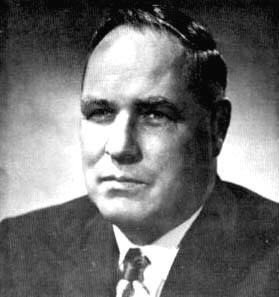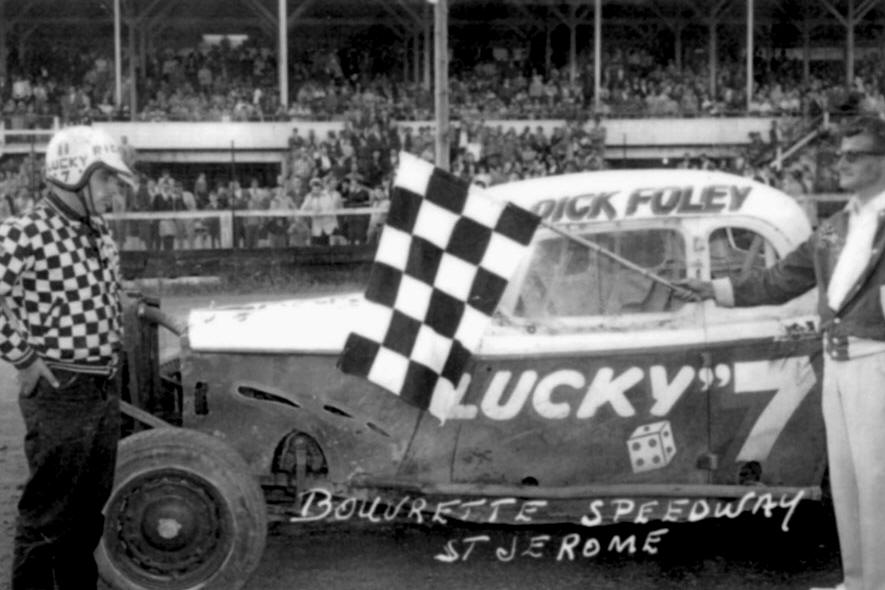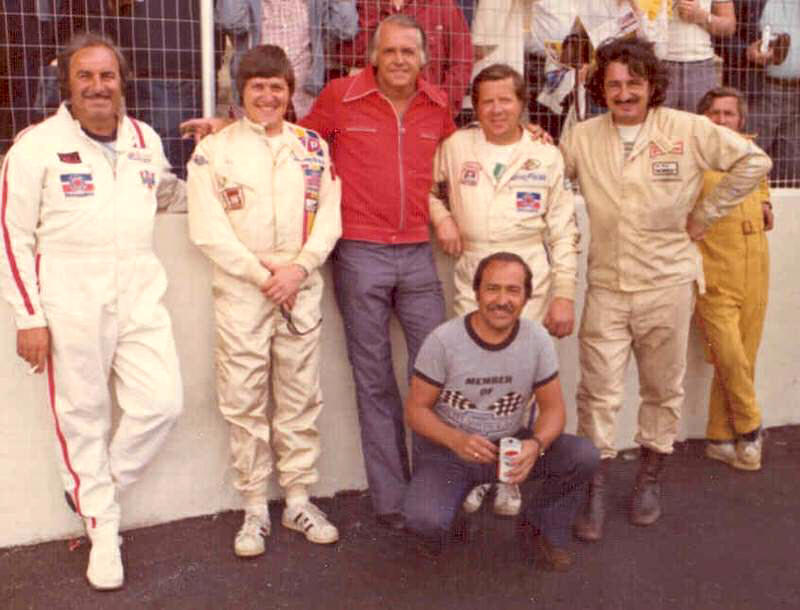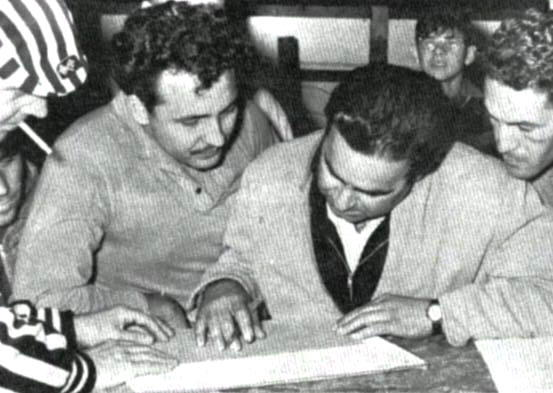LaBreche Family Collection
Roger LaBreche, Sr. stands in Victory Lane at LaPrairie’s Kempton Park Speedway after apparently
driving a feature, shirtless. Great fire safety.
BILL'S
SEMI-WEEKLY COLUMN/BLOG PAGE
BILL’S BACK IN TIME
By Bill Ladabouche
SOMETIMES IT GOT A LITTLE CRAZY UP THERE
In making Airborne Speedway a regular stopover, almost every week during the race season, I get the chance to talk some folks I would ordinarily never see. If you’re not familiar with Plattsburgh, it is very close to the Canadian border and is a popular destination for both Canadian shoppers and racing folks. Airborne has its weekly contingent of modified racers; but, it is the regular and occasional spectators in the pits from whom I get most of my best north – of – the – border material.
LaBreche Family Collection
Roger LaBreche, Sr.
stands in Victory Lane at LaPrairie’s Kempton Park Speedway after apparently
driving a feature, shirtless. Great fire safety.
The most productive source of recent years is a family, la famille LaBreche, who participate in the modified division at the track. Roger, Jr. and his son field the #100, and have been rapidly improving since moving down here from the dirt ovals such as Granby, Quebec. From LaBreche, I have gotten photographs [les photographies] of well – known ovals like the impressive old Bouvrette Speedway in St. Jerome, the more obscure ovals like Autodrome St – Martin, and even NASCAR – sanctioned Kempton Park.
But, at the end of the 2011 season, I happened to make a comment to an older man standing next to me as the fire crew was heading out onto the track to respond to a smoke – belching mini modified. The heavy – accented response immediately told me this was a Quebecois visitor, and I figured the conversation would be limited to what he could do in English. The man, named Albert Hassall and he was proudly pointing out that he had been on a track crew in Canada, decades before. One of the first interesting facts he mentioned was that the Kempton Park track, near LaPrairie QC, was ˝ dirt and ˝ paved.

Courtesy of
Richard Delisle
The senior Richard
Foley ran a tight ship at Riverside and everyone on board either shaped up or
might get
to walk the plank. Below – The younger Dick Foley preferred to be on the track
as a driver in the 1950’s.

Courtesy of Lorraine LaBelle
Hassall said he realized that even dirt tracks needed attention during accident and blown engine situations, but that it was his landing a job at Dick Foley’s Riverside track in Laval, where the pure concept of a track cleanup crew was first suggested – by Hassall. Riverside, a very flat track, was right in the urban Greater Montreal area, and spilled fluids were always a problem which delayed the programs. The Foleys, Dick and Bob, apparently could be good listeners as well as tough bosses; and Hassall ended up with a truck and a small crew to help him keep the macadam track clean and clear to race.
It was not so much track cleanup situations that engendered Hassall’s most interesting tales; rather, it was other things he happened to witness that made an otherwise mundane weekly job very intriguing. Hassall would end up developing and running crews at Laval, as well as Circuit Deux Montagnes and Autodrome Ste – Eustache. While the Foleys are an entire book’s worth of anecdotal stories, in and of themselves, Hassall’s other employer, Claude Aubin, was equally compelling.

Source Unknown
This photo hits quite
a few of the interesting names dropped by Hassall. Richard Foley, Jr. [in front]
is backed up by Claude Aubin [2nd from right] and Beaudry [red
jacket].
First, there was the story of regular New York invader Charlie Trombley, a French – speaking resident of the border town of Mooers Forks, NY. Trombley and his famous maroon and black # 5 7/8 were running some of the Quebec NASCAR tracks on a regular basis in his quest for national points. He would usually be joined by neighbor and former NASCAR National Sportsman Co – Champion, Dick Nephew, as well as the Plattsburgh area’s Melvin “Bob” Bruno and Harry Provost.

Cavalcade of Auto Racing Photo
The Quebecers largely
tolerated the rough and ready bunch from New York because a.) most of them were
French, and b.) some, like Harry Provost [2nd from left] would have
been handful to deal with.
Trombley, on his way to Riverside, had the race car and trailer careen off an exit ramp near the track and pile into a cement barrier. The Foleys, whose influence spread to a virtual monopoly of wrecker service on roads surrounding Montreal [via Andre Beaudry’s Garage Champlain], sent out trucks and scraped the Trombley car off the barrier and onto another trailer to go home. Canadian promoters always appreciated and encouraged American racing teams to compete at their venues.
As a case in point to this, venerable stock car veteran, the 90 year – old Jackie Peterson of Plattsburgh, tells a tale of how he was running for Gustave Bouvrette at the latter’s speedway in St. Jerome when he jumped a fence and broke his back. Bouvrette, alarmed at Peterson’s predicament, somehow got papers stating Peterson was a Canadian and got him admitted to the hospital, thus avoiding a long, costly, painful transport of the stricken driver back to a medical center south of the border.
Courtesy of the LaBreche Family
The Jeep pickup has opened the horse gate, but they are still in the way of the starting field. Below - a better view of the Jeep. Track owner Gustave Bouvrette is probably one of the men standing at right.
Courtesy of Andre Chausse via Stock Car Quebec SitePeterson delights in telling this story and also about how Bouvrette, whose majestic track was also a horse racing facility, would start the stock cars with his Jeep pickup that had the movable horse gate affixed on the box. Generally, whoever was stuck running right behind the Jeep got the short end of the stick and had to maneuver their around the vehicle before actually competing. Jackie gleefully recalls "gettin' too anxious" one particular afternoon and shnoving the car infront of him under the yet - unopened horse gate. This stopped the races for about an hour. he wasn't popular that day.
Courtesy of Craig Revelle
Jackie Peterson, shown here with the ever – present Bouvrette Speedway flagger, broke everything in Canada from rail fences to his own back. Below – Charlie Trombley, with a rare white Ross McNaughton car from around the period in question. He almost always ran maroon and black cars.
Bob Mackey Photo Courtesy of John Rock
New Yorkers and Vermonters, in particular, are familiar with the name of Paul Hamel. He was a former Quebec stock car champion and a frequent running mate of Jean – Paul Cabana. Driving Cabana’s backup coupe, the #5B, Hamel struck something on the track at Riverside, went entirely air – borne, and killed the flagger where he stood [looking at something else on the track]. The poor starter never knew what hit him. This was, by far, not a circumstance peculiar to Canadian tracks in those days, but it just added to the overall chaos.
Courtesy of Gerard Major
This is not a bunch whose faces you wanted to kick sand into if you went up to the Montreal area. Several are mentioned in this article and some are even alive [miraculously]. Richard Foley, Jr., Gilles Brochu, Bernie Colangelo, Paul Hamel, Jean – Paul Cabana, and Andre Manny. "A quoi regardez - vous ?"In that same season, one of Hassall’s team was in the pit area, and spotted an exiting race car, hood in the air, heading straight for a guy lying under another car – completely unaware that he was in the path of disaster. Hassall tore over to the jacked – up car, grabbed the crewman by his legs, and dragged him out from under the car. The path of the dragging happened to be through a big pool of water. Meanwhile, the exiting car had been yelled at and had stopped short of the jacked – up car.
For a moment, Hassall kind of looked foolish to the poor, dripping crewman, scrambling to his wet feet and spewing out a stream of French Canadian invectives. Still not seeing what had transpired, the guy slugged Hassall in the head. Once others intervened and the wet man realized what could have befallen him, he promised Albert a year’s worth of beer [and made good on that promise]. Hassall said he had been slugged a few more times, pulling adrenaline – crazed drivers out of cars that had barrel – rolled off the tracks at which he worked.
|
Courtesy of Jean – Guy Fournier
Not that anyone would ever have to drag anyone out of a wreck at a Canadian track. For some reason, they liked to pose with the wreckage of their cars. Kinda like standing around a dead deer or something.
Working at Riverside, in particular, spawned more screwy stories than Hassall’s other tracks combined. The Laval track had a row of trees lining the land right behind the backstretch wall, and people used to climb into those trees for a free evening of race action. That irked the Foleys enough, just on general principal alone; and Albert marveled at how people would do that, given the knowledge of how the Foleys were not exactly folks you wanted to mess with. But, when a particular car jumped the wall and slammed into one of those trees, one freeloader jumped from the tree and ended up impaled in some of the springs on the race car.
That was about enough for Foley, who then began sending Hassall and crew out to spray the tree sitters with CO2 fire extinguishers. When that did not work, the Foleys actually began to spray the tree people with tear gas. That worked pretty well until, one particular evening, the wind shifted and he gassed his own paying crowd. Apparently, not wanting any more colorful stories about that, the track saw that the trees simply disappeared one winter. [It’s lucky some of the tree people didn’t disappear, as well].
Courtesy of Paul Pleau
The offending trees are still there in this photo of the Foley’s track at Laval.
I notice no people were in the branches at the time.Several of the Riverside regular stars could not stay on the right side of the law – even the more sympathetic Quebec law. One of the top Riverside stars was on the lam, using his considerable driving skills to ferry himself out of Montreal, just ahead of some determined gendarmes. The guy, who I am not going to name, ended up all the way out to the end of the island, with bullets bouncing off the getaway car. Another, much more prominent Quebec driver, drove a getaway car from a bank robbery. He drove just fine except he turned onto a dead end street and spent several years in a Canadian penitentiary.
A third Laval regular was apparently one of the unluckiest of all the drivers – even though he once drove the famous Quebec stock car #Lucky Seven. This guy had a beautiful coupe which he brought down into Vermont to race and ended up having the brand new car burn to the ground. Later, he was working for the wrong people in Quebec and ended up in prison, where he was shot to death. A fourth Riverside driver, one who had been one of the pioneers of racing in the region, ended up blown up in his Chrysler outside of the some Quebec road house.
Studio Jean Photo From Owen Family Collection
Vermont driver Gordy Owen poses with his Ralph Bushey #31 at Noel Raceway in Brassard.
I wonder if he ran into any rivals with their Sunday best on.Brassard’s Noel Raceway, named for the promoter, was another place Hassall worked with starting up a track crew. He relates how one man, apparently coming right to the track from church [remember these ARE French Canadians, and the Catholic church is a big deal to almost everyone up there]. He arrived with what must have been the family car, which he intended to enter into the racing. He managed to roll the car over on the muddy track - in one of the early qualifiers – before things had dried out. They dragged him out, dress suit and all, through the muddy puddles on the track apron. Hassall recalls that the track crew had to “feel around” in puddles for the man’s wallet.
At the same track, one guy was black-flagged, but he kept going on the track. For several minutes, while annoyed management looked on, the car continued to evade officials and hold up the program. When the flagger became more demonstrative, the recalcitrant driver made a U – turn and took direct aim at the flag stand. The flagger dove to safety and other drivers, recruited by the track, had to finally crash the idiot to stop him.
Courtesy of Linda Gravel
Lucien LaLonde looks at though he might not be preparing for what one would call a “responsible” night of racing. Do the beer bottle and the gleeful passenger give any clues ?
Fire control, in the early days of stock car racing, left a lot to be desired. Hassall recalls how one of the first car fires at Riverside took eight fire extinguishers to put it out. An irate Foley told him that was what was planned for an entire season of fire fighting at the track. They quickly learned to be more realistic. Those few tracks that had the huge extinguishers mounted in the back of a pickup, found that these didn’t work dependably. The powder in the tanks would settle, after a year or two on non – use, and the device would then fail when they needed it the most.
Often, early track crews were hesitant to get near these fires due to both intense heat and inadequate equipment. At one track, Hassall remembers being supplied with those over – the – shoulder water tanks that men use to march into forest fires with. Imagine battling a gasoline or oil – fueled car fire with a device that squirts little amounts of water at a time.
Courtesy of Dean Wright
Most early racing fires were just allowed to burn out. Few tracks had any serious fire extinguishing capability. This is Naples, NY - but it could easily be in Canada.
Hassall, photographer Norman Morley, Jackie Peterson, the LaBreches, and others have supplied me with numerous tales of mayhem from the well – known tracks like Riverside and Deux Montagnes, and the hole – in – the – wall venues like Kempton Park, St. Martin, St Paul L’Ermite, Noel, Fury, and numerous others. Dirt tracks, paved tracks, and half – and half tracks all make up the craziness that was stock car racing in the province of Quebec in the 1950’s and early ‘60’s.
Courtesy of Gerry Bergeron
Drivers ham it up for the camera at the Ste-Martine track in 1951. Check out the marvelous catch fence protecting the spectators. Below – Gilles Brochu, one of the pioneers of Quebec stock car racing, visits Victory Lane at the Waterloo fairgrounds track in 1950. Nice safety gear, Gilles ! Amazingly, racing isn’t what killed him.
Courtesy of Phil GevryPlease email me if you have any photos to lend me or information and corrections I could benefit from. Please do not submit anything you are not willing to allow me to use on my website - and thanks. Email is: wladabou@comcast.net . For those who still don’t like computers - my regular address is: Bill Ladabouche, 23 York Street, Swanton, Vermont 05488.
AS ALWAYS, DON’T FORGET TO CHECK OUT THE REST OF MY WEBSITE
www.catamountstadium.com
Return to the Main Page
Return to the Main News Page
Return to the All Links Page
Return to the Weekly Blog Links Page